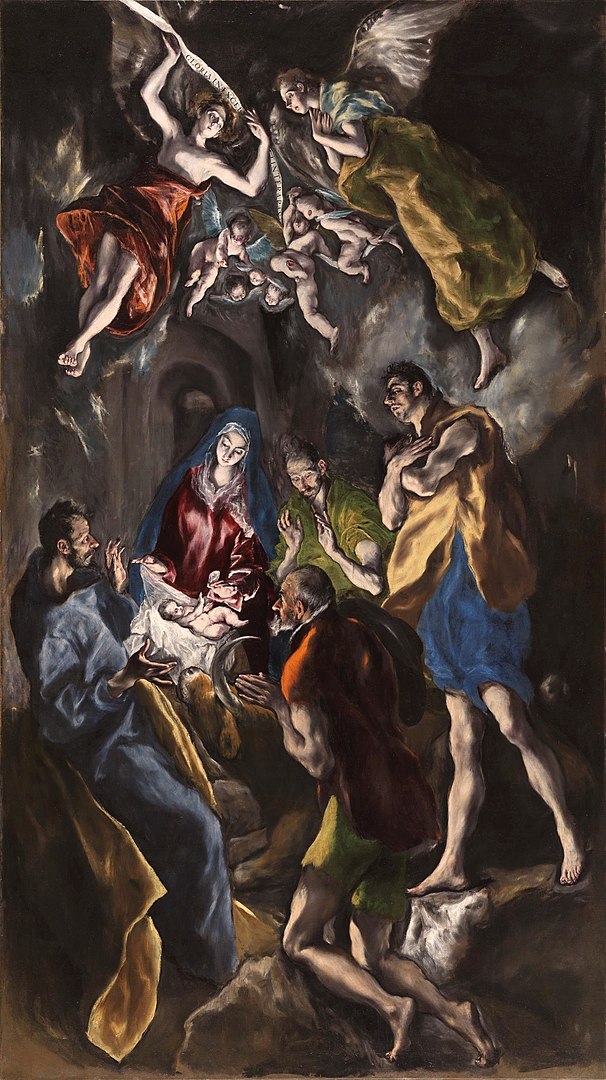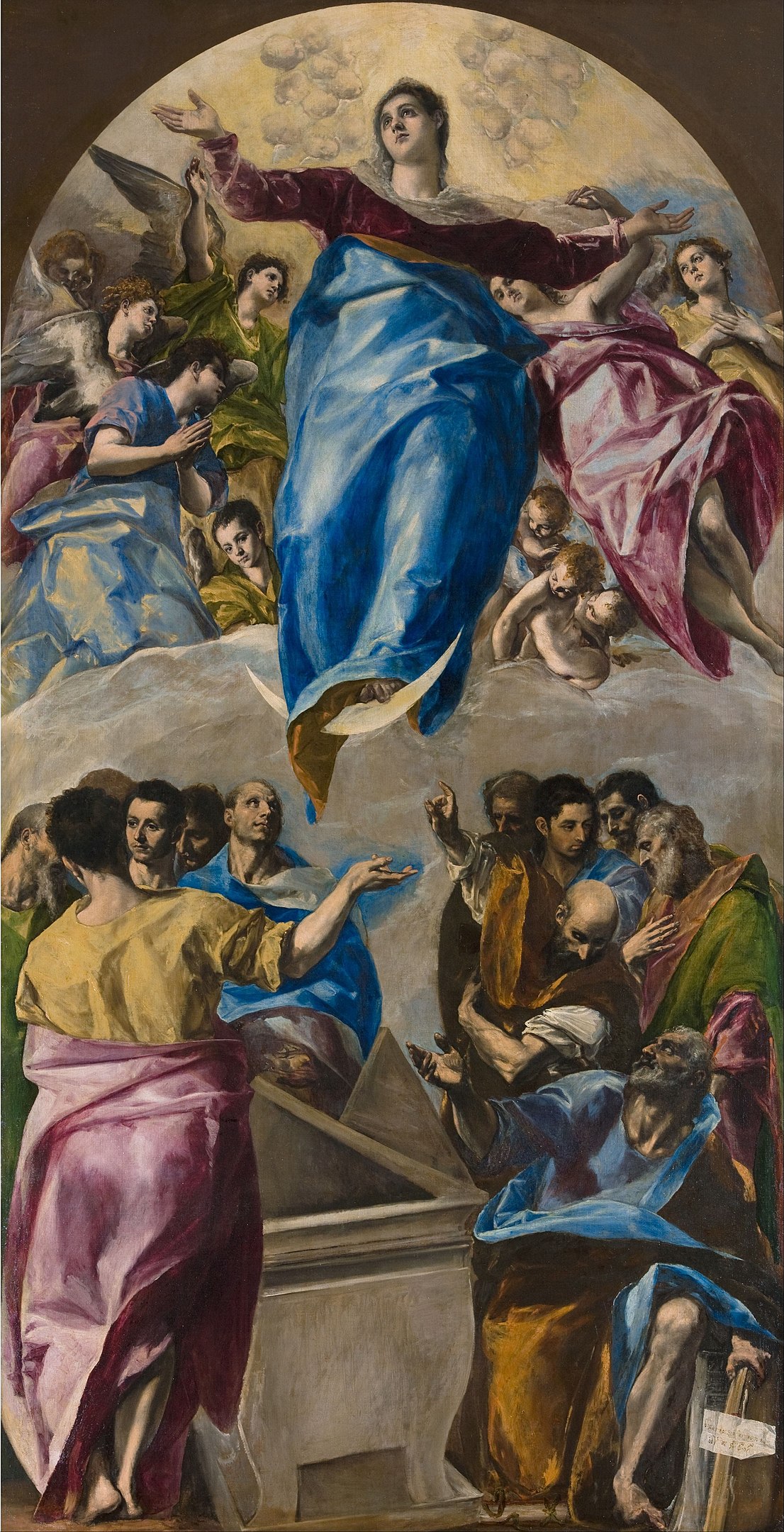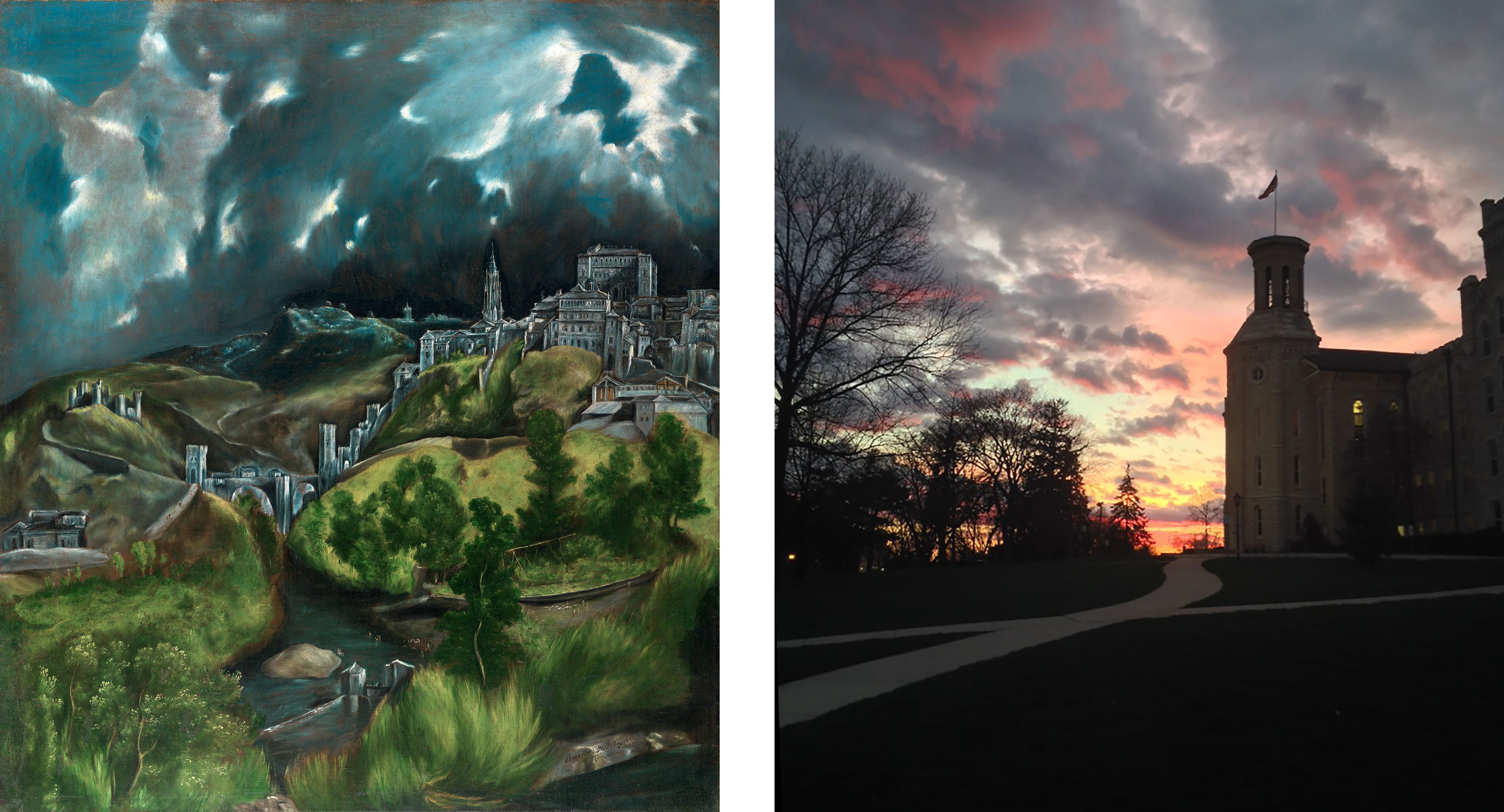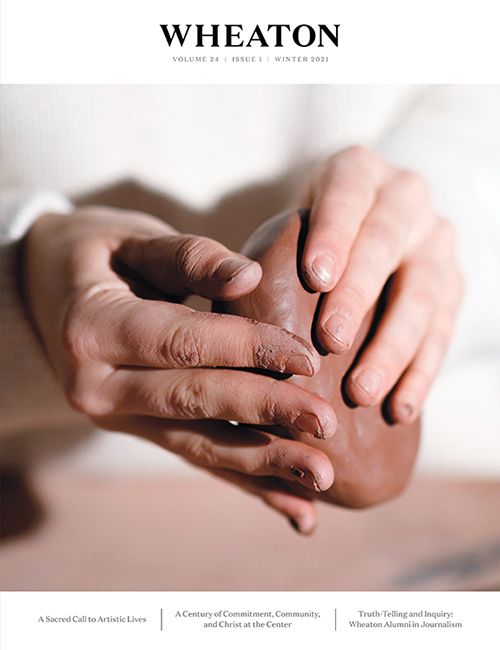El Greco’s Task, And Ours
Why Wheaton’s Renaissance Art course has not been canceled
Words: Dr. Matthew J. Milliner ’98, Associate Professor of Art History

The Adoration of the Shepherds
Wikimedia Commons
This year Yale University caused a stir by canceling its core Art History course that focused on Renaissance art. One Yale alumna, writing in The Wall Street Journal to protest Yale’s decision, summed up the discipline of art history with memorable verve:
Art history is the quintessence of the liberal arts, encompassing aesthetics, philosophy, political history, geography, even chemistry; that introductory class gave such a sweeping, engaging, diversely relevant view of Western culture that it was frequented by budding physicists, engineers and actors as much as by future art historians.
The writer—Shannon Vowell, now on staff at a Methodist church in Texas—certainly gets it.
As a citizen of academia, I am compelled to diplomatically add that Yale may have had good reasons for this curricular adjustment. But to be honest, the cancellation of this storied course put a mischievous spring in my step as I proceeded with our own Renaissance Art course here at Wheaton, which was being taught just as Yale surrendered theirs. It is frequently claimed that the early evangelical fervor of Yale has been passed on to institutions like Wheaton that continue to openly profess Christian faith. Can something similar now be said about subjects like Renaissance art?
I expect some might think we persist in teaching this subject because our Eurocentric biases cloud us from seeing the irreducible complexity of global art history. Not in the least. We study Chinese, Japanese, Indian and Meso American art here with enthusiasm every semester. Several times I have taught an Advanced Integrative Seminar with Dr. Tiffany Kriner on Native American Art & Literature. Above all, at Wheaton we continually drive home the point that the Christian liberal arts, emerging from the seedbed of Alexandria, is a fundamentally African enterprise.
Our Renaissance art course endures for different reasons: Namely, if we do not study the Renaissance, we will be influenced by it anyway. The influence of the Renaissance—whether through action figures (the Teenage Mutant Ninja Turtles), video games (the Assassin’s Creed series completely recreates Renaissance Florence and Rome), or Netflix shows (there are competing dramatizations of the powerful Borgia family, for example)—is still pervasive. And more than those obvious connections, many have claimed that the screens we look at too much every day are themselves the distant progeny of that famous Renaissance invention: linear perspective.
In other words, we study Renaissance art at Wheaton not only to be influenced by it, but just as much to resist its influence. Moreover, we do not go to the Renaissance to avoid topics like race and gender. Instead, alongside our admiration of the era’s undeniable beauty, the inherent diversity of our Christian faith generates critiques of how Europeans first depicted Africans and Native Americans; and far from endorsing the proliferation of the female nude, we frequently question such depictions from a Christian perspective. Long before contemporary feminist art historians theorized about the troubling “male gaze,” our Lord delivered his own opinion on the subject (Matthew 5:28).
And so, last semester we threw ourselves into studying the Renaissance for all these reasons and more, and the class was intended to culminate with student-led tours of “Ambition and Defiance,” the El Greco show at the Art Institute of Chicago. This once-in-a-lifetime exhibition gathered some of the greatest works by this Greek artist under the same roof. There were loans from nearly 40 museums and private collections, including the Louvre, the Prado, and the Met. Wheaton students have been leading tours at the Art Institute for the last several years, and this tour promised to be the best of them all.
And so it was that our defiant Renaissance Art class was going to conclude, until COVID-19 intervened. First, our in-person classes were transitioned online, and then the El Greco show was postponed as well. Inadvertently, we found ourselves in a similar place to Yale—with our course in Renaissance art being effectively canceled. (I hope this teaches me not to gloat.) That said, our students persisted brilliantly, creating beautiful video projects from home that showed how plagues often stimulated, rather than squelched, art production in the Renaissance. Still, our disappointment was intensified because El Greco encapsulates everything we are about as a Christian college. I was able to visit the show personally just before the city-wide closures put it behind locked doors, and I’m sorry to say that no online representation can do it justice. Still, let me try to give an account of this remarkable show and how it encapsulates the Renaissance, if only to keep up with the fantastic COVID-19 presentations my students created themselves.
As with all of his contemporaries, El Greco (1541-1614) was faced with a revival of Graeco-Roman pre-Christian culture that provoked some Christians into a hidebound reaction to paganism, and others into an enthusiastic embrace. Outright neo-pagans included the daring Greek scholar George Gemistus Pletho (d. 1452/4), who not only promoted Classicism, but may have worshiped the ancient gods and goddesses as well. The effect Pletho had on Italy was well conveyed when the warlord of Rimini, Sigismondo Malatesta, had Pletho’s body exhumed and installed in a virtual pagan temple that Sigismondo had constructed for himself. On the other hand, many figures were deeply suspicious of the culture of humanism. The cautious Orthodox bishops who attended the Council of Ferrara-Florence (1438-45) were understandably puzzled by the glitzy Italian images that surrounded them. Many of them were convinced that the arrogance of Western Christianity, with its overemphasis on natural reason and natural sight, would be its undoing. And in part, they were right.
But still, other Renaissance personalities were able to engage the culture of humanism without losing their Christian bearings. These thinkers and saints attacked rationalism, but used reason to do it. They were cautious about overemphasizing physical beauty, but did not forget the beauty of creation or the beauty of God. The figures include theologians like Gregory Palamas (d. 1359), Thomas à Kempis (d. 1471) and Birgitta of Sweden (d. 1473); artists such as Fra Angelico (d. 1455) Piero della Francesca (d. 1492), and (of course) Michelangelo; and reformers like Savonarola (d. 1498) and (obviously) Martin Luther. Each of these figures managed to bring the cultures of humanism and Christianity together in different ways. But perhaps the one artist most exemplary of such a fusion was the Renaissance sculptor, painter, and architect El Greco.
El Greco was reared as an icon painter on the Venetian-controlled island of Crete that was still richly saturated in the icon-soaked culture of Eastern Orthodoxy. His real name was Doménikos Theotokópoulos, but as continental Europeans seem not to have been able to pronounce it, they just called him “the Greek” (El Greco). After learning the trade of icon painting in his homeland, El Greco then plunged into the culture of Venice and Rome and finally, Toledo in Spain. But far from being embarrassed by the Orthodox faith that formed him, he permitted it to permeate his work, and even defiantly signed his paintings in Greek, asserting (not suppressing) his Cretan origins. This would be like a Midwestern Wheaton graduate making her way to New York, Los Angeles, or Washington, while not hiding her faith—something Wheaton graduates in fact often do.
El Greco’s first attempts at Renaissance-style painting are admittedly awkward. In his early Lamentation and Entombment that was on view at the Art Institute of Chicago, El Greco was both a bad icon painter and a second-rate Tintoretto (Titian’s great Venetian rival). He was like so many young Christians today who know their faith needs to expand, but who cannot quite fit all the new pieces together into a coherent and manageable whole. We might say he was filled with answers, but not yet filled with that which transcends mere answers: namely, faith.
_-_Christ_on_the_Cross_-_Google_Art_Project.jpg)
Christ on the Cross by El Greco
Wikimedia Commons
But El Greco found his synthesis, as so many Wheaton students do as well. What made the Art Institute show so worthwhile is that it offered viewers tangible inspiration and equipment in this task. Those interested in the role of women in the Renaissance, for example, now have a series of marvelous specialized studies at their disposal. But a canonical artist like El Greco is surprising in this area. In traditional paintings of the Crucifixion, beneath the cross lies the skull of Adam, a visual reference to 1 Corinthians 15:22, which reads, (ESV) “For as in Adam all die, so also in Christ shall all be made alive.” But in one of his Crucifixions (Christ on the Cross, 1600/10), El Greco depicts two skulls, one of them belonging to Eve. This is a defiant and necessary reminder that women (it should go without saying) are included in this salvific transaction as well.
In both of El Greco’s images of the penitent Peter, it is the preaching mission of women (highlighted in all four Gospels) that brings hope to the failed male disciple. He depicts Mary Magdalene rushing from the tomb to give solace to the despairing disciple. What is more, in a culture where mystics like Teresa of Ávila towered alongside John of the Cross, El Greco gives us a penitent Magdalene in the exact posture of the far more frequently painted St. Francis. And unlike the more titillating images of Mary Magdalene by Titian, El Greco’s manage to be beautiful while also being chaste. The famous contortions of El Greco’s bodies are not designed to sexually arouse, but to arouse a higher love for God.
The white bodies on display in this show are enough to cancel the Renaissance for some—there is just not enough diversity. And there is a crucial point here that we cannot miss. In one of his works, El Greco paints the Theban legion, a group of Christian Roman soldiers from Africa who were martyred for their refusal to worship idols. The figures should be black, and are instead cast as white. This is regrettable indeed. Full stop.
But if the predominantly African American audience at the member preview I attended is any indication, Chicago can handle El Greco nonetheless. This, after all, is the city where images of the Black Christ have dominated churches for well over a century—a story told splendidly in Kymberly Pinder’s Painting the Gospel: Black Public Art and Religion in Chicago (2016). In fact, this might make Chicago one of the most appropriate global cities to host this exhibition, precisely because El Greco’s paintings were here surrounded by so many city-wide paintings of the Black Christ. Further, El Greco himself was an ethnic minority. To call him “the Greek” was perhaps something of an insult, reminding El Greco that he was not in the Italian or Spanish cultural mainstream. But “the Greek” mastered a foreign culture. He is an example of what the contemporary African American painter Kerry James Marshall called, in his blockbuster exhibition, Mastry. Like Marshall, El Greco mastered a foreign culture to compete on its own terms.

Assumption of the Virgin
Wikimedia Commons
But not without defiance. Many Wheaton alumni will recall the massive El Greco Assumption of the Virgin (1577-79) in the Art Institute, which is nearly always on display. For the first time in 200 years, this exhibition unified this painting with its companion images, including a massive depiction of the Trinity. But no commentators (to my knowledge) have pointed out that there may be an argument here for the Orthodox way of seeing things. By making it seem as if the Holy Spirit is flying from the Father, El Greco may be defending the Orthodox (not Catholic) formulation of the Nicene Creed.
To the continual chagrin of Orthodox Christians, Western Christians added the filioque clause (“and the Son”) to the Creed in 589 AD. Moreover, the filioque clause was added in Toledo, the very city where El Greco’s image was painted. Should this be true, it makes El Greco’s Trinity an assertion of his Orthodox identity in the heart of Catholic Spain—one that went unnoticed by the Inquisition. In the same way, I hope any Wheaton students who “succeed” in American life would also defy the places where our culture tempts them to surrender their Christian habits and convictions. And like El Greco, I hope they get away with it!
But lest this seem an impossibly high demand, I am reminded of the continual attempt by the Wheaton chaplain’s office to keep the accent on the ordinary Christian life, centered not on our own aspirations and efforts, but on the undeserved grace of Christ. It was a point inadvertently made in the El Greco show as well, where El Greco’s famous Assumption could be seen alongside his last painting, The Adoration of the Shepherds (1612-14), under which the artist hoped to be buried. In this towering Last Will and Testament, the ox’s horns below the Christ child are a reminder of the sacrifice Christ made on our behalf. But those horns also resemble the moon that Mary stands astride in the Art Institute’s famous Assumption, a subtle reminder that we stand aloft not on our own merits, but on the merits of Christ—and this includes Mary as well.
What is the upshot of all this for twenty-first-century Christians? In the face of the slickness of the Renaissance, El Greco ably competed with acumen and verve, but without total surrender. He realized that there were limitations to the Orthodox culture that reared him, and in addressing those limitations, he developed the expressive potential of the eyes, the hand, and the body. But he recognized the limitations of the mainstream visual culture as well. Faced with the excesses of nudity in the Renaissance, he mastered the nude figure, but he also knew when to put the clothes back on. He effectively used drapery to amplify his theological points.
In short, El Greco sailed the high seas of Renaissance art while still anchored to his Greek Christian identity. “If the feminine stuff of sixteenth-century mysticism comes out in some of [El Greco’s] religious pictures, it was because he was painting to order for the Church. But essentially he was not religious.” That unfortunate statement, which passed for scholarship nearly a century ago, completely misses the point. Far better are the words of the great historian Peter Brown, who once said to me in passing that El Greco was “the last of the hesychasts,” that is the last of the great Orthodox mystics. But in fact, he has inspired, and is inspiring many new Christian mystics today as well.
,-his-hand-sending-pilgrims-on-the-road-to-Santiago,-and-St.-James-the-Less-(161014),-his-hand-pointing-down-to-rootedness-and-stability2.jpg)
St. James the Great (left); St. James the Less (right)
Wikimedia Commons
In our increasingly slick, unstable, and vulnerable society, we need new El Grecos: artists who have mastered Renaissance visual technologies, but who refuse to leave the icon behind, defiantly signing all their contributions in Greek. El Greco reminds me of my Art Department colleagues Joonhee Park and Gregory Halvorsen Schreck, who insist that their students master video and photographic technologies not so that they can merely replicate the wider culture, but so that they can fight back. In other words, we need believers rooted in ancient Christian culture who vigorously engage their own. This point was perfectly expressed at the Art Institute exhibit in the contrast between El Greco’s portrait of St. James the Greater (1608/10), his hand sending pilgrims on the road to Santiago, and St. James the Less (1610/14), his hand pointing down to rootedness and stability. El Greco—who left Crete for greener Italian pastures but finally found them through his commitment to Toledo—knew both impulses, and so must we.
By the good grace of God, Wheaton continues to be a place where these twin impulses, the peripatetic and the permanent, are still at work. Gazing at El Greco’s famous depiction of his adopted hometown of Toledo (1599/1600), whose conservative structures happily accommodated his infusions of artistic life, I couldn’t help but think of the mystical recesses of Teresa of Ávila’s classic text The Interior Castle, and of the windswept skyline of Wheaton, Illinois, as well.

View of Toledo by El Greco (Left) and photograph of Wheaton's Blanchard Hall by Dr. Milliner (Right)
